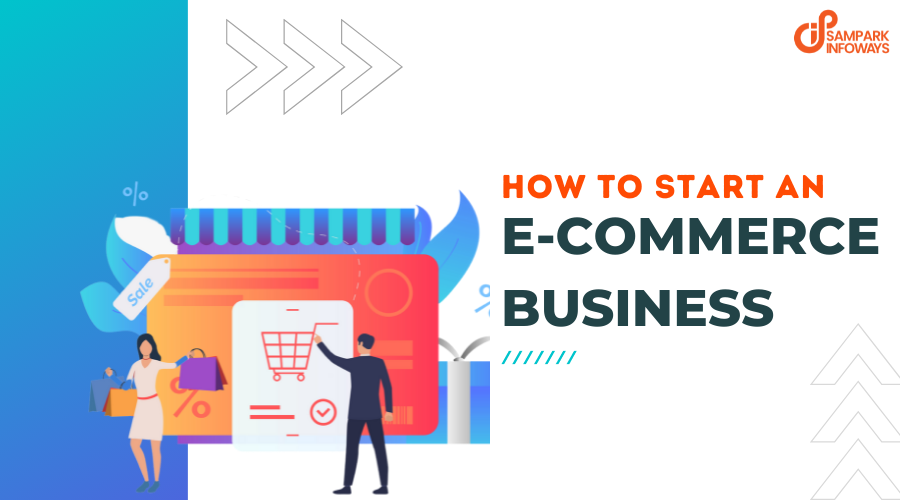As the Internet has become an inevitable part of our lives, the list of opportunities it provides is endless. We can leverage so many benefits from this world. One such is starting a successful e-commerce business. Yes. It has such a scope today, that every business tries to have their online store if their products are even closely suitable to be sold online. This post will tell you about every step that you need to follow to start an e-commerce business. Give it a thorough read and for a more detailed guide to the process, download our e-book. It explains the steps in great detail with short insights into the general trends in the steps involved.
But before letting you know the steps to a successful e-commerce business, let us tell you what an e-commerce business is.
Table of Contents
What is an E-Commerce Business?
E-commerce is basically the buying and selling of products with the help of the Internet and most commonly, accepting payments through online mediums. E-commerce businesses have websites/apps online, wherein they showcase all the available products with the company and the customers can choose from that which product they like. They can place the order online and most often, websites provide the option to let customers pay online. Although, most e-commerce businesses allow Cash On Delivery too as an option. These days, people are always on their mobiles, so e-commerce has kind of become mobile commerce through the internet.
The most common examples are – Amazon, Flipkart, eBay, Nykaa, etc.
Advantages of E-Commerce Business
There are many advantages of e-commerce and that is why e-commerce is a very popular and highly growing sector today. Some of them are :
1. Less effort for clients – It is fast when it comes to choosing the products. You don’t have to dress up, step out, drive to a marketplace, get assistance in a shop to look for products that you need. What you need to do is just to open the website/app which opens up within seconds, search for the product that you need, which again takes such less time. And with a tap of a button, your order is placed.
2. Huge catalogue and easy navigation – Online catalogues have the ability to store a large amount of product information with great detail. Also, the algorithms these days have the ability to search for the products that you type within seconds. You can easily find the exact thing that you need.
3. No middlemen & less cost – The cost of products is less as compared to traditional market, because the need for middlemen is eliminated.
4. Greater reach & visibility – With an online presence, you can reach to a wider audience. Even if you aren’t shipping to specific locations yet, people might still know your brand who might be your potential customers in the future when you wish to expand. With Internet, it is easier and cheaper than before, to get visibility.
5. Marketing & Advertising options – With an online presence, you have a large variety of options to choose for your advertising. You can leverage on the fact that people are online for a long duration of their daily life. You can create engaging content and attract the audience.
Knowing all this information about e-commerce, you must be even more excited to start your own. It’s now time to know the steps you need to follow to start your own e-commerce business.
Steps to Start an E-Commerce Business
Step 1: Choose your product
You might have had a sudden inspiration seeing something and knowing it right then, that’s the product you want to sell. Or, you might have no idea about what to sell. In the second case, you need to do a research on what products you can sell and which products are in the trend at that moment. You can go for a simple Google search or you can also use Google Trends. Google Trends is a tool that examines the popularity of top search queries in Google across various regions and languages.
Step 2: Market Research and Competitive Analysis
Once you know which product you want to sell, you need to study about the current market trend to understand whether there is scope for your product or not. And how much scope does it have for great sales. You need to do a SWOT analysis for your product i.e. you need to identify the Strengths, Weakness, Opportunities and Threats. Only then you can know what to focus on and what to avoid.
Also, it is very important that you research about the existing brands which might be a competition for your product. You need to know what are you standing up against. What are the practices they are following, what are their sales strategies, what all mistakes have they done.
Step 3: Plan your business model
Next, it’s time for you to plan your business model based on the information you have gathered after the deep research. Decide how you want to sell the products. Do you want a one-product, niche or a multi-product store? How will you source your stock? Where will you get them from and what will be path that your products will follow to reach the consumers from the vendors? Decide what will the pricing strategy will be. Decide what margin you should have on the profits. Think of where you will store the procured products and how will you ship them.
Step 4: Name your brand & do legal procedures
Naming of your brand can also happen in the initial stages when you know what product you want to sell. Keep in mind that the brand name projects the core value or the product idea that you want to convey to your consumers. It should be catchy.
Also, don’t forget to check whether there are any competitors with the same brand name. Also, check whether there already exists a domain name on the internet same as your brand name.
Once you have decided a name for your brand, it’s now time to do some legal formalities. There are some important steps like getting your company registered, opening a bank account in the company’s name, getting the required permits and licenses, etc.
Step 5: Buy a domain name
Check whether your brand name is available as a domain name or not. If not, try to reach the owner of the domain and ask if you can buy it from them. Else, you can try domain name combinations that depict your brand. There are certain websites where you can buy the domain. GoDaddy and Wix are some sites which have a lot of domain names available to be bought.
Step 6: Choose an e-commerce platform
Now, you have to plan the actual store that would be visible to your consumers – and that is your e-commerce website. There are many ways in which you can set up your e-commerce website. You can either build the website from scratch – which will require coding and hence, developers to work on your projects. Consult expert software professionals to do so, as this is a very crucial step.
Also Read: How Sampark Infoways can help you set up your business with its IT services!
You can also opt for online platforms that help you build your e-commerce website. Sites like Shopify and plugins like WooCommerce for WordPress will provide you elements to build your e-commerce store and the best part is, you don’t need coding for it. These sites help you create your product catalogues, integrate payment gateways in very simple and easy-to-understand steps.
Step 7: Start building the website
Let’s start the actual building of the website. Decide what pages you need. Some basic pages will always be there like Home Page, About Us, Products Page. Decide the color scheme, have relevant high quality images. Make your pages as attractive as possible. Decide the content and try to keep it as appealing as possible. Integrate payment gateways and present an image that your website is safe and secured for transactions. Add cart features to save items that the customer is interested in. Add blog articles if needed. Integrate analytics to keep a check on the traffic statistics of your website. This is very important to devise marketing strategies and know which tactics work and which don’t.
Step 8: Optimise your website
Once the website is set up, it is time to check the analytics and understand what is going right and what is going wrong. Try to improve the site-load speed for your website. Get your images optimized and compressed so that they don’t cause delay in page loading. Visitors get a negative impression if site takes long to load. Optimise the content so that your website is SEO friendly which means that your website is easily discoverable when someone searches for products your business offers. Include blog articles included relevant keywords and search terms.
Step 9: Start Marketing
Now starts a very important step and i.e. marketing your products and making people know your brand. Decide how the product will be packaged when it is shipped. It helps build quite an impression amongst the customers. Build a social media presence for your brand. Get Facebook and Instagram pages for your website and add promotional content that drives customers to your website. There are so many ways to generate traffic on your website and then more ways to convert that traffic into sales. If you start getting orders, give a really nice customer experience, as word-of-mouth publicity of your products will drive your sales, like in any other business. Use Facebook, Instagram and even Google Ads to target customers who might be interested in your products.
Step 10: Traffic Analysis & Sales Tracking
Once the website is live, you need to analyse the traffic statistics to understand what’s attracting the customers and what’s driving them away. Check the bounce rate, click through rate and average traffic data. Integrating Google Analytics with your website will help you to understand your visitors. Modify your content accordingly based on how the visitors react.
Once sales starts, you also need to analyse and understand that. Which products are more in demand, which are not driving any attention, what is the average expenditure of the customers,etc. Understand what kind of products do you need to add more. Analysis is a very important part. It will enable you to devise the right strategies that will help grow your business. Make sure to fill your stock timely and update it based on the trends.
And voila! Your e-commerce business is set up! You can now market more and more, add interesting products and do trials and errors for different business tactics.
To know about each step in detail of this entire process of setting up an e-commerce website :
Download our E-Book
Get interesting insights about the various tactics to drive traffic, popular methods to increase your search engine rank, make your brand visible on social media, etc. Click here!
For expert consultation on how to start your e-commerce business from scratch, contact us. We are Sampark Infoways and we deal in all-round IT solutions for your business. It would be fun having you on board.



